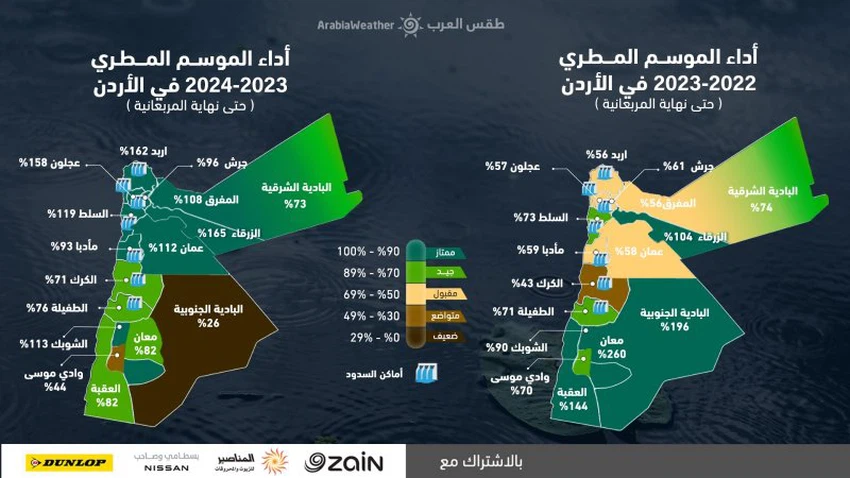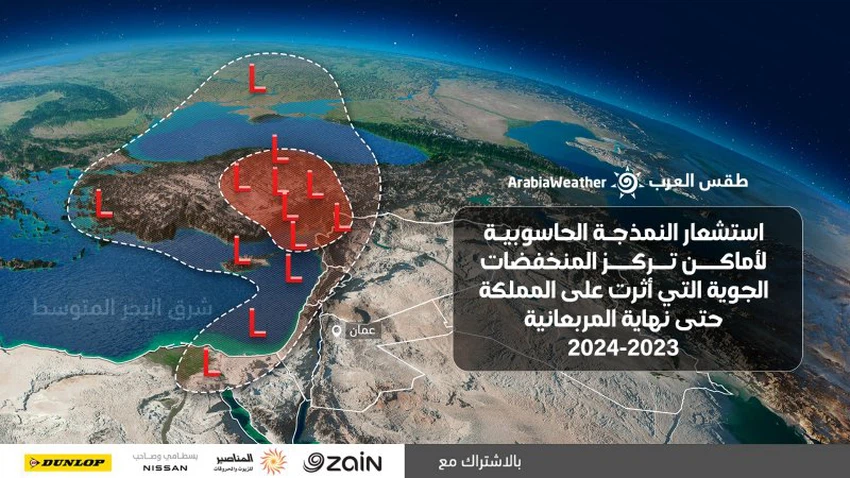Climate report: Winter square gives a strong boost to rainfall totals, exceeding their rates in agricultural areas, but still weaker than usual in the southern regions.
Arabia Weather - The Regional Arabia Weather Center issued a comprehensive report to monitor the prevailing rain reality in Jordan. The report included several axes, including an analysis of the rain performance up to the moment and its comparison with past seasons, and a look at the number of weather depressions and their severity that affected the Kingdom until the end of Al-Murabaniyya. The current climate is in addition to the weather system that has prevailed in the region since the beginning of the rainy season.
Evaluating the reality and performance of the 2023/2024 rainy season so far
Rain performance is defined as the percentage of the cumulative amount of rain that has fallen compared to the amount of rain that is supposed to fall until a specific date, which is calculated based on what was recorded on the ground during the past thirty years in the same period of the year. To evaluate the reality of the rainy season in a given period, we must look at several aspects:
- Rain performance in the Kingdom’s governorates up to the moment and comparing it with the average of the entire annual rainy season.
- The number and severity of weather depressions that have affected the Kingdom so far.
- Comparing the number of weather depressions this season with previous seasons.
First: Rain performance in the Kingdom’s governorates so far:
Data from the Jordanian Meteorological Department show that at the end of Al-Murabaniyya and the beginning of the Khamseen this winter, the rainy season is considered in most agricultural areas (including the northern Jordan Valley) and the areas where dams are concentrated in Jordan (north and center of the Kingdom) have recorded a distinguished performance for the rainy season until... This moment exceeded the expected rates for this time of the year 1-2-2024, with the exception of the eastern regions, the southwestern highlands, and the southern Jordan Valley. This is in complete contrast to the last season, when the Kingdom Valley and the southern regions were characterized by an unusually excellent rainy season.
When we compare what has been achieved regarding the actual amount of rain falling in this rainy season with what is supposed to fall, we find that the performance of the rainy season so far is as follows:
- Exceeding the assumed totals: Zarqa 165%, Irbid 162%, Ajloun 158%, Balqa 119%, Shobak 113%, Amman 112% and then Mafraq 108%.
- Concerning the assumed totals: Jerash 96% and Madaba 93%.
- Lower than the assumed totals: Aqaba and Ma’an 82%, Tafila 76%, Karak 71%.
- Much lower than the assumed totals: Wadi Musa 44%, and the Southern Jordan Valley and Southern Badia have recorded a very weak season so far, with 36% and 26% respectively of what is supposed to rain on them.

It is worth noting that the highest rainfall total during the Al-Murabien period amounted to 324 mm, at the Ras Munif monitoring station / Ajloun Governorate, achieving 245% of its general average for the Al-Murabien period, and it is also the highest in rainfall amounts since the beginning of this season until this date, in total. Rainfall amounted to 525 mm, 90% of the general seasonal rain rate.
Second: The amount of rainfall achieved in relation to the entire annual rainfall average:
When we compare what has been achieved regarding the actual amount of rain falling in this rainy season with the entire annual rainfall average (which ends in the month of May), we find that, to date, no region has reached its annual average, and this is normal, as it remains until the end of the rainy season. More than three months, including the Khamseen of winter, which constitutes 38% of the rains of the general rainy season, but despite that, for example, Ajloun and Irbid came close to that, in addition to the city of Zarqa, which has achieved until this moment approximately 90% of the annual rain rate. While the entire southern and eastern regions, except for Mafraq and Shobak, are recording less than 50% of the annual average rainfall so far, and we ask God that the situation will improve in the coming months in these regions.
Third: Comparing the number and intensity of weather depressions this winter with last season and the one before it:
The number of weather conditions that affected Jordan in the current rainy season 2023/2024 has increased significantly and significantly compared to what was the case in the last two seasons 2022/2023 and 2021/2021, as the Kingdom was affected this season until the end of Al-Murabbaniyah by about 21 weather events distributed between... 7 classified depressions and more than 14 unclassified weather conditions (either in the form of an extension of a depression or cases of atmospheric instability). Whereas, if we take the number of depressions of the third degree or higher (strong depressions that bring significant amounts of rain to all regions), we will find that the current season lacks the presence of strong depressions, as shown below, and it is similar to the last season.

Despite the large number of weather events, they were not mature enough to include all regions
This can be explained by the fact that the northern regions of the Kingdom enjoyed high rates of rain during the past weeks, as despite the large number of weather events, their succession, and their non-interruption for long periods in the region since the beginning of the rainy season, as mentioned above, they were not as deep as Enough to be classified as advanced grades, and it was not winter-ripe. At that time, the northern regions and parts of the central region benefited from such weather conditions, as the impact of the weather activity was concentrated on these regions, at the expense of the southern and eastern regions, which are experiencing a fairly acceptable rainy season until this moment, and we ask God that the situation will improve.
The attached map shows the locations of the concentration of depressions since the beginning of the rainy season, as despite their abundance compared to the past few years, they were located in a superficial center far from the Kingdom, which made the southern and eastern regions outside the scope of the majority of weather events.

Arabia Weather App
Download the app to receive weather notifications and more..



